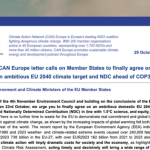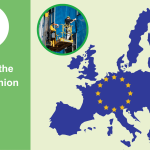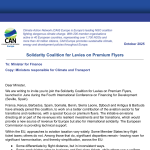At COP28, all parties should agree to a rapid, just and equitable global phase-out of fossil fuels in all sectors in line with the 1.5C temperature limit by 2050 at the latest, without abatements. As a major historic emitter, the EU needs to take a lead in mitigation, but also upscale its support to developing countries in implementing climate action on the ground and building trust. This is why bilateral partnerships are so important. As part of the much-needed, just global energy transition, the EU must furthermore scale up from the verbal support for developing countries indicated in its COP28 position to strong financial commitments and technical assistance to accelerate the shift to a people-centred, fully renewable energy system.
The EU has a wide diplomacy toolbox, from financial instruments (including the EU budget Global Europe Instrument, its climate finance components and more specific initiatives such as the Global Gateway), to its foreign policy institutions (such as the EU External Action Service, EEAS) and in various fields of international policy-making, under the UNFCCC, in relevant energy policy spaces, and beyond. With this multitude of instruments from both EU institutions and member states and given their involvement in international institutions (including powerful weight on the boards of Multilateral Development Banks, diplomatic initiatives and bodies), the EU has various opportunities to significantly contribute to coordinated advances required for climate justice and to advance concrete partnerships with countries and country groups. For these climate partnerships to be successful, they need to be centred around human rights and development and inclusivity, and be gender transformative – which has been lacking so far in the green deal’s foreign policy dimensions. Also, key EU officials, from Commission President von der Leyen to the commissioners responsible for the European Green Deal and climate action, have been increasingly engaged recently in bilateral diplomacy with major regions to advance partnerships, including on climate and energy matters. These are often intertwined with multilateral policy discussions and they are both a tool to build progressive international positions as well as to deliver concrete technological and financial support. The first days of COP28 with announcements at the World Climate Action Summit add to the picture.
New dynamics in European Green Deal partnerships post-Covid?
After a certain COVID hiatus which affected the possibilities of physical meetings, work on the EU’s bilateral partnerships and cooperation with key countries and regions in the Global South seem to be picking up speed again.
At COP27, for example a Memorandum of Understanding on a strategic partnership on renewable hydrogen was signed between the European Commission and Egypt. In July this year, a summit between the EU and Latin American countries took place during the Spanish presidency. In 2023, also Green Alliances were established and announced between the EU and Norway and the EU and Canada, the latter just one week before the COP. It seeks to „strengthen efforts to drastically reduce greenhouse gas emissions in the highest emitting sectors. They will work to accelerate the global phase-out of unabated fossil fuels and end the construction of new coal-fired power“, in line with the recent COP28 conclusions adopted by the EU.
With India, a long-standing partnership which CAN Europe and CAN South Asia analysed in more detail recently in a briefing paper, various high-level meetings took place earlier this year in India in particular. These addressed inter alia a partnership between the EU, Africa, and India under the umbrella of the International Solar Alliance (ISA). An announcement during the India-hosted G20 summit this year received remarkable public interest, namely to develop the „India-Middle East-Europe Economic Corridor (IMEC)“ which will link Asia and Europe through the Arabian/Persian Gulf. It is expected to „include not only rail and port links for faster trade, but also electricity cables, a clean hydrogen pipeline and a high-speed data cable“, that „are tremendously important to the EU“, a research source commented. Commission President Ursula von der Leyen called this „the most ambitious project of our generation“ in her 2023 SOTEU address.
An EU-China summit, the first in four years, is scheduled for 7/8 December 2023.
With regard to alliance building, a “Joint Statement of the Organisation of African, Caribbean and Pacific States and the European Union for COP 28” serve as another example of how the EU can engage with other country groups on position building for the international climate process. 27 EU countries and 79 countries from the regions involved highlighted, among others, the principle of common but differentiated responsibilities and capabilities in light of different national circumstances, and underlined that “the shift towards a climate neutral economy, in line with the 1.5ºC goal, will require the global phase-out of unabated fossil fuels and a peak in their consumption already in this decade.” It also backed the demand for tripling of installed renewable energy capacity to 11 TW and doubling of the rate of energy efficiency improvements by 2030 and included those in the COP28 negotiated outcomes, and called for more ambition on adaptation, loss and damage and means of implementation. While based on the EU-OACPS Partnership Agreement, the statement itself, however, does not contain any concrete aspects of the bilateral cooperation between the groups or references to the support EU plans to provide, it focused clearly on a political message into the COP.
Global gateway: how much people-centred climate action and development in this private sector finance tool?
According to the European Commission, Global Gateway is the „European strategy to boost smart, clean and secure links in digital, energy and transport sectors and to strengthen health, education and research systems across the world“, launched in 2021. It aims to mobilise up to €300 billion in investments through a Team Europe approach, bringing together the EU, its Member States and their financial and development institutions. Green energy transition and green hydrogen is one of its six key areas, with „Critical raw materials“ and „Transport corridors“ also being of particular climate relevance. On 25/26 October, the European Commission hosted the „Global Gateway Forum“ in Brussels and signed a number of agreements on the sidelines of the conference in areas such as renewable energies (with Bangladesh, Tanzania, Viet Nam, Philippines, Senegal) critical raw materials (DRC and Zambia, Uzbekistan). The conference received NGO criticism as an „invitation-only, closed-door gathering, a PR event dominated by politicians and business leaders, rather than a meaningful space to consider the role of the Global Gateway in sustainable development.“ Civil society and trade union voices were largely absent.
In CAN Europe’s view, the EU’s Global Gateway Strategy should exclude support for fossil fuel activities and infrastructure. Energy financing should be dedicated to energy access and just transition through maximising energy efficiency and progress towards fully renewable energy systems, increasing finance for, and access to, gender-just climate solutions led by grassroots and feminist organisations in the Global South and not just large infrastructure projects. Just energy transition partnerships should be democratically owned, based on local expertise, knowledge and needs, and workers’ rights as well as target gender-inclusive employment, and respect human rights. Moreover, given the Global Gateway’s focus on securing EU geopolitical and commercial interests, the Strategy has seriously compromised the focus on climate impacts, despite this being a priority for partner countries and a major criticism of the European Green Deal. A Climate Resilience with Africa initiative was launched at COP27, but many more dedicated adaptation initiatives are needed. A briefing paper coordinated by CAN Europe also found that gender considerations were shockingly absent from the Global Gateway communication, which, surprisingly, also missed any references to the EU’s Gender Action Plan III, for example, which was adopted a year before. An E3G report prepared for the European Greens also highlighted the need to “integrate human rights and gender equality considerations into co-development dialogues, as well in due diligence processes” of the Global Gateway, among other recommendations. An analysis by the German Development Institute also highlights the concern that “Investments in authoritarian countries serve to stabilise regimes, and it is more likely that human rights and environmental concerns will be sidelined before projects are abandoned and private capital is lost.”
A draft list of Global Gateway Flagship Projects for 2024 seen by CAN Europe, which might be released in the course of COP28, includes over 60 projects under the „climate and energy“ heading and another 30 „transport“ projects. Financial information is not available yet. Many of those projects can be expected to deliver positive contributions to the expansion of renewable energies in particular. Partnerships on issues such as critical raw materials, however, will require closer scrutiny to ensure that sustainability and human rights concerns are addressed, that local communities and countries have the opportunity to benefit from the full / greater share of the value chain, and the EU is not just seeing those countries as suppliers of raw materials to the interest of EU industry. Furthermore, there is the concern that many of these capital-intense projects, while having potentially important climate benefits, may be overall accounted for towards the EU’s climate finance contribution. This will have to be looked at critically in the years to come. Delivering local level benefits to communities is also a major concern.
Grant finance: an undervalued critical enabler for Just Energy Transition Partnerships (JETPs)
Since COP26 in 2021, Just Energy Transition Partnerships (JETPs) have emerged as a new collaboration instrument between countries, with the EU and some member states playing a critical role. The JETPs have been described as a „novel plurilateral and long-term approach to supporting climate actions in carbon-intensive developing countries at risk of a carbon lock-in“. On the funding side, it includes the International Partners Group (IPG) with large finance packages to support country-led just power sector decarbonization strategies that reflect enhanced climate ambition and related national development priorities, including expanding energy access and developing low-carbon energy value chains. The JETP with South Africa marked the first step in 2021, and more JETPs have been initiated since then, including Indonesia and Viet Nam. A JETP with Senegal is also under discussion, a political declaration was released by the partners in June 2023 indicating that a roadmap should be finalised by COP28.
Obviously, implementation experience is still fresh, and what is clear is that such JETPs cannot be a one-size-fits-all approach. Civil society organisations have laid out proposals for principles that should underpin the partnerships, including
- Encouraging stakeholders to raise ambition and work collaboratively to curb global temperature rise in line with the 1.5°C target;
- The development of successful and truly “just” JETPs requires transparency, meaningful multi-stakeholder engagement, and good governance
- Financing must be new and additional, make use of a country-appropriate mix of financial tools which are sensitive to debt levels, and serve the public interest.
COP28 may also bring news in terms of implementation progress and financial agreements to advance the implementation of JETPs. However, developed countries seem to approach those partnerships with a heavy bías on concessional loan finance. According to recent reports, in the JETP with Viet Nam, developed countries have only offered 2% of the overall volume as grants, and Indonesia has shifted closure dates for coal power plants in response to insufficient grant finance (2.5%) as part of the package. This analysis comes with the finding that, at least, the EU or member states are among those with a higher, but still very small share of grants. At COP28, the government of Viet Nam and the partners from developed countries officially launched the Resource Mobilisation Plan which specifies financial details of the current “offer”. The European Union specifically is aiming to provide USD 185 million as loans/technical assistance and USD 735 million as concessional loans, plus contributions from Denmark (10 million grant), France (1.3 million grant, 523 million loan), Germany (62 million grant, 609 million loans), Italy (264 million loans and 264 million yet to be determined).
Even if the costs of these JETPs reflect a larger investment approach than just incremental, additional costs of climate action, offers with higher grant shares could make it easier for the implementing countries to go further.
EU collaboration not (yet) free of fossil fuels
An EU climate and energy collaboration agenda free of financing for fossil fuels still needs to be achieved. Some of the recently signed partnerships raise critical questions around the „greenness“ of hydrogen, and the role of natural gas in particular. Even if some of these deals were made to facilitate the phase-down of fossil fuel imports from Russia following its invasion of Ukraine, there are concerns that the EU is not yet on track when it comes to consistently and coherently designing its partnerships in line with the 1.5°C limit and phasing out of fossil fuels, as two relatively recent examples show:
- Building on the 2022 signed “Memorandum of Understanding on Strategic Partnership in the field of energy between the European Union and the Republic of Azerbaijan, both signed a more specific MoU that should pave the way for up to 9.5 billion cubic meters per year of Caspian gas to be delivered to central and eastern Europe by the end of 2026.
- EU and Argentina signed an MoU in July 2023 on energy, aiming to cooperate in the deployment of hydrogen and its derivatives, renewable energies, energy efficiency as well as natural gas and liquefied natural gas (LNG).
Overall, while the objectives of the European Green Deal increasingly can be seen in bilateral partnerships of the EU, there is still much more that needs to be done to come to a truly consistent approach in line with the 1.5°C limit, the EU’s responsibility to deliver on its climate finance commitments in a credible way and to truly align the financial flows it provides and supports to others with the Paris Agreement Goals, according to Article 2.1c which the EU in particular is aiming to give more prominence in the UNFCCC process. For these climate partnerships to be successful, they also need to be centred around human rights, development and inclusivity as well as be gender transformative.
Sven Harmeling, International climate policy coordinator at CAN Europe
—
For media: If you have an interview request, question or you would like to be added to the CAN Europe COP28 media list, please get in touch at communications@caneurope.org.



